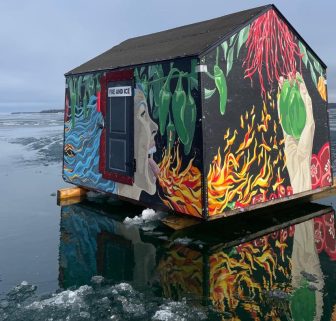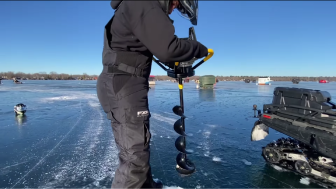
Ice fishing is central to Ontario’s recreational culture, with over 100,000 combined members of online groups dedicated to the sport. Image: Hot Box Huts
By Daniel Schoenherr
At Lake Simcoe in southern Ontario, February has traditionally been the peak of ice fishing season.
But this year, the lake’s freezing cycle is in purgatory, continuing to fuel what many locals are calling Ontario’s worst ice fishing season in decades.
Most of the lake is inaccessible to anglers, with reports of cracking ice in traditionally safe areas. Only a small, frozen bay remains as a bastion of hope for anglers.
Donny Crowder, owner of Hot Box Huts in Churchill, Ontario, said many of the lake’s ice problems come from daytime temperatures reaching well above freezing.
Two to three-degree below-zero days with moderate winds are needed to create the first thin, frozen layer on lakes. Then the water beneath begins to freeze to create a safe, thick layer of ice.
Erratic temperatures have repeatedly melted this winter’s first layer of ice before it can thicken, said Crowder, who rents ice shanties to anglers. Few areas of the lake have ice thicker than six inches, a common standard for deciding when the ice is safe enough to place shanties.
“We’re waiting for that good, solid ice to come,” Crowder said. “It started the process, got it kicked off, but it didn’t finish the job.”
Despite the season’s climate challenges, anglers have a beacon of optimism: Cook’s Bay, a small area at the south end of Lake Simcoe.
The bay has developed about seven inches of ice due to its shallow depth, Crowder said. Combined with its proximity to the Greater Toronto Area and the prevalence of lake perch, the bay is incredibly popular with anglers.
“Most people on Cook’s Bay are kids and families. They try to get on it because it’s closer,” he said. “Now, with the sketchier ice on the main body of the lake, we’re noticing an increase in anglers on Cook’s.
“And it has actually created some problems.”
Hundreds of huts, vehicles and sleds are squeezed into spots that fish hut operators deemed safe, he said. The overcrowding has become so bad, Hot Box Huts had to lock the portable toilets it provided for clients because other anglers filled them in a single day.
The worst consequence of the overcrowding has been the degradation of the bay’s access points, Crowder said. Many areas where people get on and off the ice are now unusable because of the heavy traffic, making it difficult for businesses to transport equipment.
“We have concerns due to shoreline degradation because of the heavy angler traffic, but we have ways of dealing with it, like making bridges to get across for people,” he said. “But when it comes time to get our huts off, we’re going to need enough ice to be there.”
Luke Ledlie of Fishsimcoe Hardwater Outfitters, said his charter operating out of Cooke’s Bay hasn’t faced as many problems compared to others on the lake.
“Everybody is wishing they could get out fishing earlier,” Ledlie said. “There’s just a general disappointment because of the delay.”
Outfitters like Ledlie have become accustomed to a later start to the ice fishing season. According to a 2017 study from McMaster University, Ontario had fewer cold days and more warm nights each winter, with average temperatures rising over 1.5 degrees Celsius since 1950.
Over the 15 years Ledlie has operated his charter, he’s seen a mix of good and bad seasons. But the bad are beginning to become more prevalent, he said.
“Ice fishing, where we live and with the climate we have now, is a February sport,” Ledlie said. “If you’re counting on time in January, well, you’re probably not gonna get that.”

Ashley Basperson, co-owner of ice fishing outfitter Hot Box Huts, uploads weekly Lake Simcoe ice reports online, checking the thickness and safety of the ice cover for anglers to her social media channel, Unbroken Outdoors. Image: Hot Box Huts
Ledlie said he has seen more anglers out on boats this season, but he can’t recommend it. Boats can get easily damaged if left in the water for an extended period of time during a freezing period, and nearshore ice can cut into hulls when getting a boat in and out of the lake.
“They get longer in their boat, but there’s a small breed of people that are willing to do that,” he said. “It’s cold. Cold and wet and windy. The lake can be a gnarly place with the cold water temperatures and you’re out in a boat.”
Ledlie expects to get customers out on the ice soon.
Terry Goy of Terry Goy Fish Huts has been running an ice fishing outfitter for 50 years on Lake Simcoe. Goy used to put his huts out from January to March, but the season has narrowed to little more than the month of February.
“People aren’t going as much,” Goy said. “When it’s cold every day and night, the phone rings off the wall but now, it’s very quiet.”
Goy said he doesn’t have too much hope for the future of ice fishing on Lake Simcoe, blaming climate change for the reduction in ice cover.
“That’s the way it’s got to be, I guess we caused that problem,” he said. “I’m 74 years old. We had snow storms where we couldn’t get out when we went to school. When the bus got stuck, all the kids got under the bus and pushed the bus out of the snowdrift.
“We don’t get storms like that now.”